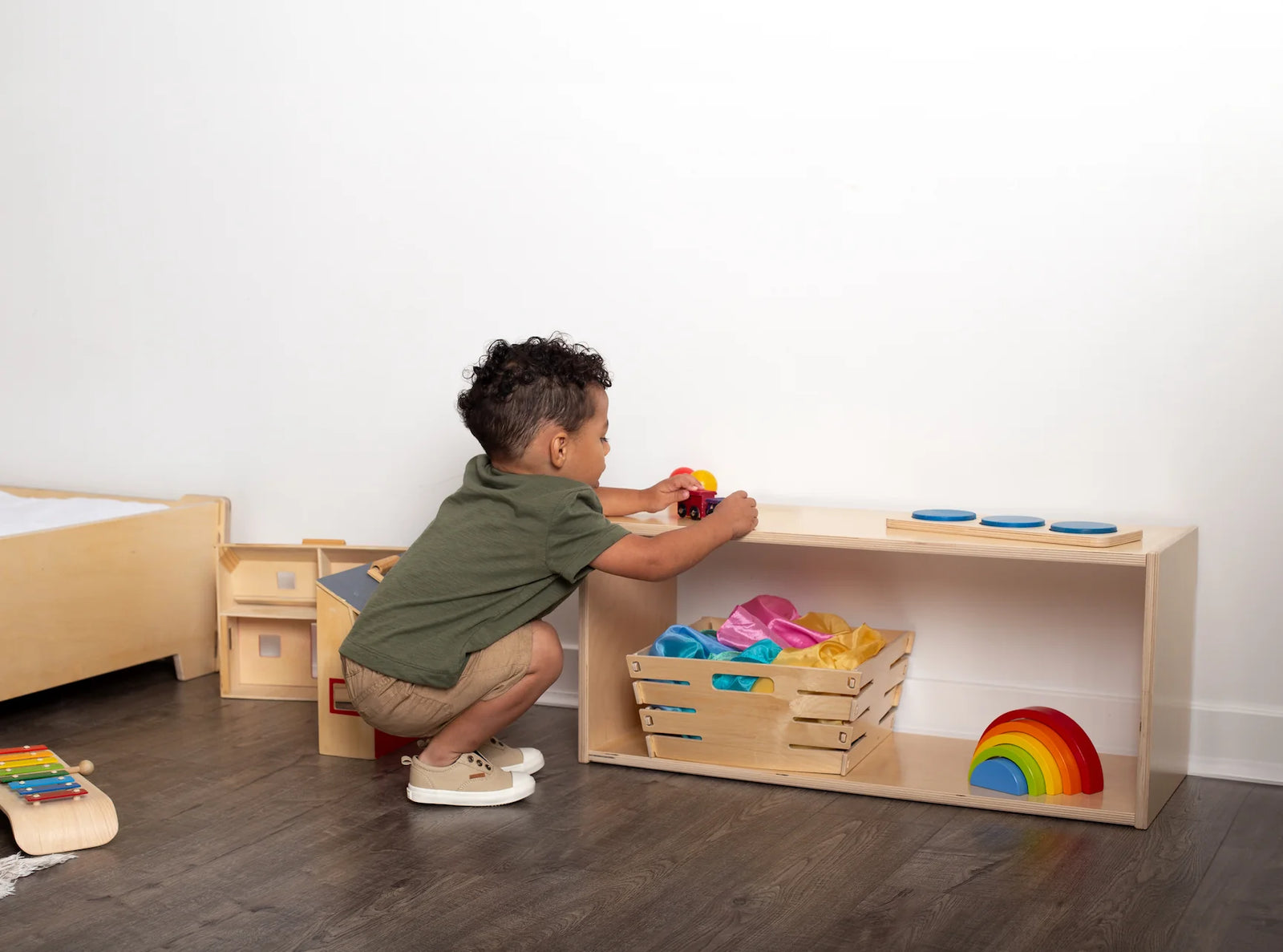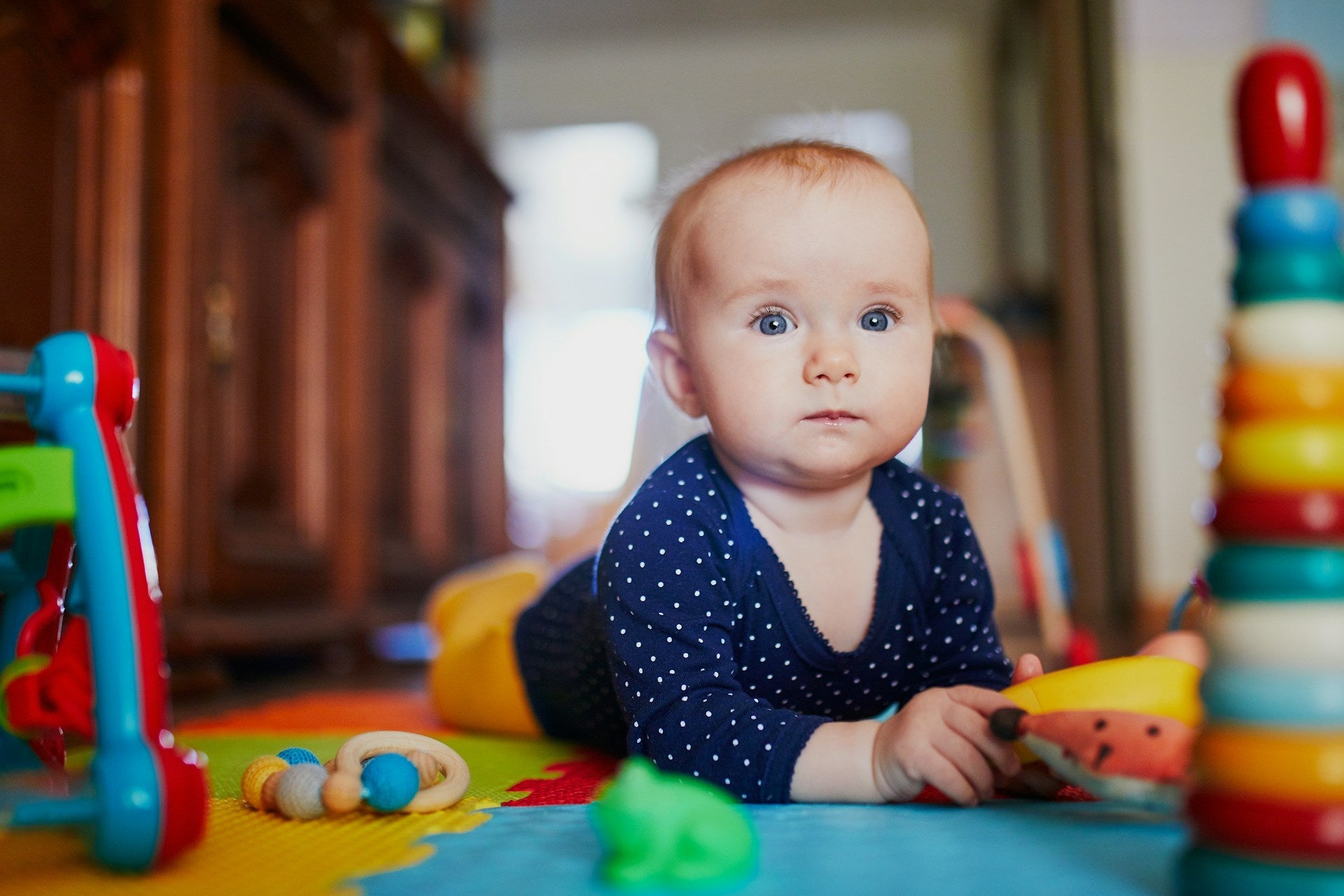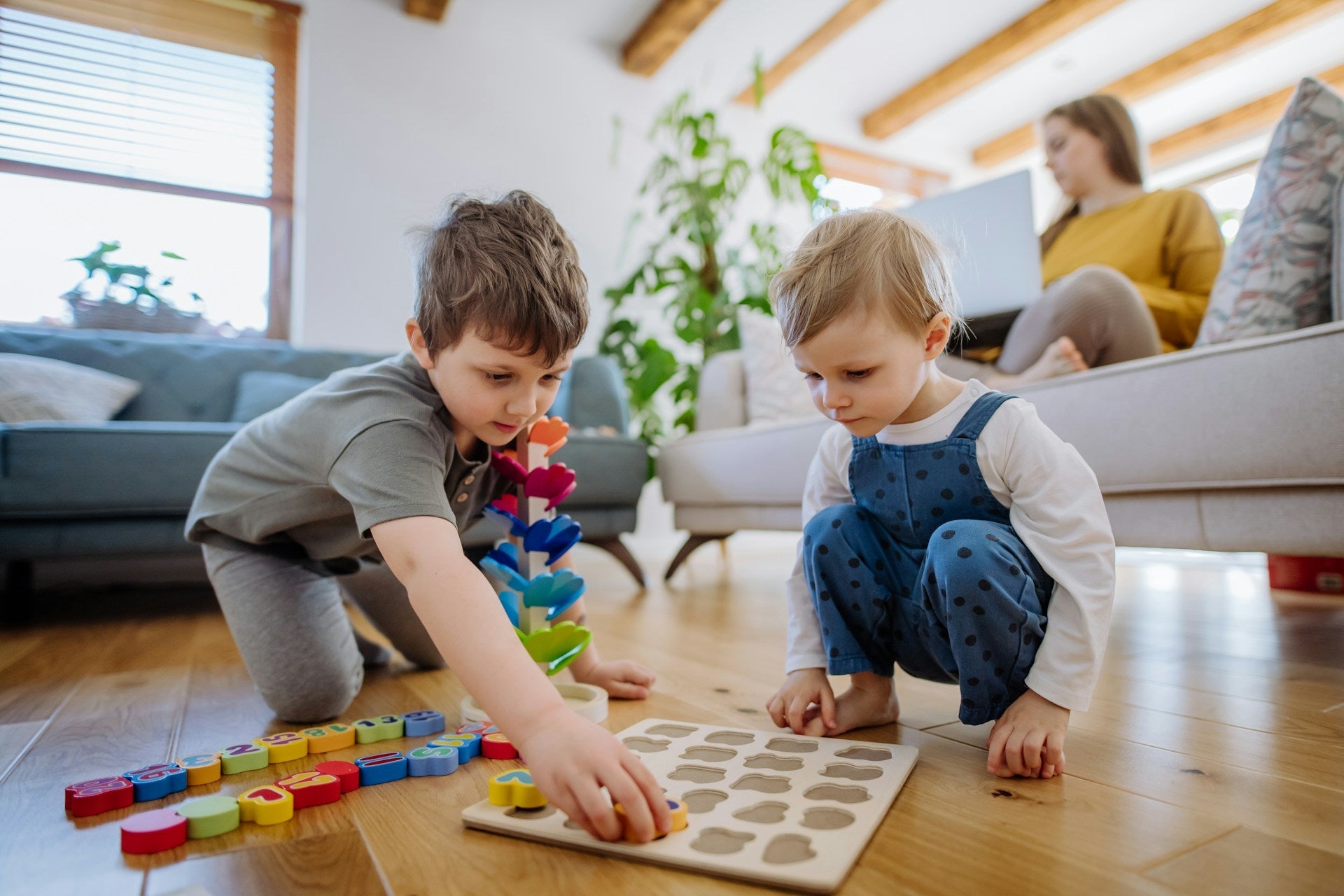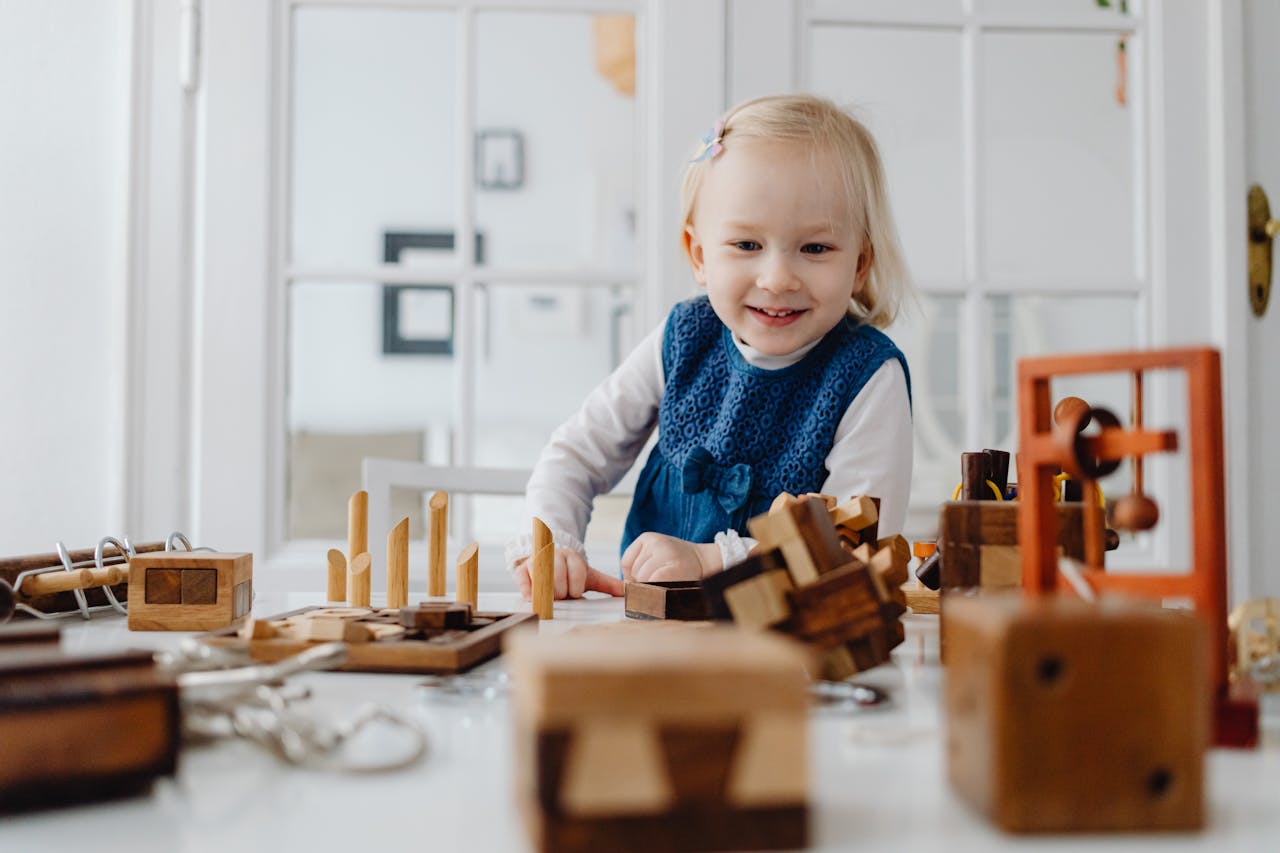The Power of Nature: Montessori Wooden Toys for Infant Growth

"When children come into contact with nature, they reveal their strength." -Dr. Maria Montessori
Dr. Montessori posited that natural materials such as wood, stone, bamboo, etc., best served and engaged children in their learning and growth. She also favored nature and the outdoors as necessary teachers for the children. Children could reach their full potential by engaging with Earth's raw materials. As time has passed, her position has been proven true (as is the case concerning her theories). Recent research confirms many benefits to using natural materials with children, from increased focus and concentration to a calming effect.
When you enter a Montessori environment, you may immediately notice how many materials are made of wood. This is an intentional choice, aware of the exceeding benefits of wood to synthetic materials, such as plastic. While you may find some plastic or other synthetic materials in Montessori environments, most will be wood and other naturally sourced materials (think glass, ceramic, metal). The prepared environment (which Dr. Montessori conceptualized) prioritizes simplicity and beauty. Favoring simple and natural material toys over bright synthetic toys better creates a beautiful and calming atmosphere. This is true for both children and babies. And what better than wood for your baby's first toy?
There are so many benefits to using wooden materials with your baby. Simple wooden toys help children to focus and develop their concentration. In Montessori, we know the high value of concentration and that this skill can be observed from birth. Giving your baby natural materials to engage with lets them explore and focus on the material itself rather than combat overstimulation by toys that are brightly colored or make noise. Another benefit is that wood has been shown to have a calming effect on children.
Because of their simplicity, you can get more use out of wooden toys. They lend themselves to creativity, exploration, and even imagination. While your baby may not use their imagination yet, many of the wooden toys used in infancy can be used for imaginative play as the child ages.
Because they have more uses, you only need so many toys. As we know, in Montessori, less is more; this is a massive advantage of having a few quality toys rather than an abundance of cheaper toys. Wooden toys are also more aesthetically pleasing than brightly colored plastic toys, which creates a simple but beautiful atmosphere. Do you want to mention environmental benefits here?
When your baby plays with wooden toys, they experience a quieter and gentler introduction to the world. In the period of the Absorbent Mind, authentic experiences are more valuable than artificial ones. This includes your baby's toys. Wooden toys can teach your baby cause and effect, object permanence, problem-solving, creativity, and many other essential skills and abstract concepts. Because they are intentionally designed with your baby's development in mind, they provide age-appropriate stimuli but have the benefit of growing with your child as your child discovers more uses for them.
Wood is also a more sustainable and environmentally friendly material. Wooden toys also last longer than plastic toys, so you get more use. They can even be passed down between children and always stay in style. Because it is a natural material, wood is safer for the environment and your baby. Babies put everything in their mouths, and wood is an excellent material for babies to explore orally. Wood is also more durable and less likely to break, allowing plenty of opportunities for repetition. There's a reason wooden toys have been around for so long.
After your baby has finished exploring the Montessori Visual Mobiles, they can begin exploring with their hands and practicing their grasp. Some of the most well-known Montessori baby toys are the grasping ring, interlocking discs, hand rattle, grasping beads, and rolling rattle. Each wooden toy is designed with your baby's development in mind and serves a distinct purpose. The child from 3 to 6 months is experimenting with more hand movements. This is the perfect time to introduce grasping materials, such as the above items. These materials strongly support the development of the baby's fine motor skills.
The grasping ring is a single wooden ring, entirely sanded smooth. It is the perfect size for a baby to experiment with grasping and releasing. There are multiple ways to use the grasping ring, which can serve different purposes as the baby ages. One way to use the grasping ring is by hanging it from a ribbon in the baby's movement area. They can practice batting at the ring and feel great accomplishment when they grab it with their palm and fingers. The ring can also be hung from elastic rather than ribbon. The elastic gives them feedback as they pull on the ring and feel it tug away. Because the elastic has more give, the baby can also pull the ring to their mouth, a discovery treat since babies use their oral senses to explore. The ring can also be used independently, placed on the ground near the baby to let them practice directing their arms to reach for the ring. It can also be used as an aid for teething as the baby ages. Wood is an ideal teether because it is natural rather than artificial. Smooth but firm wood is soothing for sore gums.
As the name suggests, the interlocking discs are two circular disks interlocked. You can find them permanently interlocked or as fitted puzzle-like pieces. They are the perfect size for small hands to grasp them well. The interlocking discs allow babies to practice hand-to-hand transfer, an essential gross and fine motor skill. Because they are using both hands together, they engage both sides of their brain or cross the midline. This will have developmental benefits for your baby's movement and coordination. Because the discs are interlocking and seem to have no end (permanently glued discs), they also serve as a visual interest for your baby. They will observe the discs and engage their visual senses as they hold the discs in their hands. Looking at this single object with both eyes helps to develop their binocularity. Because it is larger than the grasping ring, there is more of a challenge. This will not deter your child because humans want to reach self-perfection; they will enjoy the challenge and satisfaction of being able to manipulate the discs. Again, the natural wooden texture of the discs can also serve as a teether to soothe sore gums. While this item is simple, it allows for a lot of exploration.
A wooden hand rattle is another multipurpose toy for your growing baby. This is one of the most recognizable of the Montessori wooden baby toys. The hand rattle consists of a small wooden dowel with rings and two large beads on the ends. This rattle demonstrates cause and effect for a young baby as they shake the rattle and hear the sound it makes due to their movement. The rattle can fit in one hand but can be transferred between hands, again engaging the crossing of the midline. Babies often enjoy teething on the large wooden beads on the end and exploring the rings on the dowel. They can also practice grasping and releasing the rattle when placed near them in their movement area.
Grasping beads are another well-known Montessori wooden baby toy. Are they usually made of round beads strung together? Leather or cotton cords are knotted between each bead, though some are made with square or other shaped beads. Though these toys may seem simple, they are engaging and offer generous support for your baby's development. As with other Montessori materials, the simplistic beauty of this toy captivates the interest of young babies. Because the beads are tied onto flexible rope or cord, they offer a variety of movements rather than a more rigid construction. This allows for a full range of hand motion when grasping the beads. Some people even tie the beads to a ribbon or string in the movement area to let the baby learn the rings from above rather than on the ground. The beads' natural texture offers the baby valuable sensory input as they explore each piece. They can slide the beads from side to side, encouraging coordination, fine motor development, and problem-solving. This toy also allows babies to engage their core and bilateral movements as they transfer the beads between their hands.
The rolling rattle is beautifully composed with a cylinder construction of small dowels and two circle closures on each side. The rattle contains wooden beads or a bell, which make lovely sounds as it is shaken or rolled. This toy is a beautiful aid to movement as your baby is encouraged to creep or crawl after the rattle when it rolls away. Your baby can also learn cause and effect and problem-solving as they explore rolling or shaking the rattle. Because it has multiple dowels around the cylinder, there are plenty of opportunities for grasping and hand-to-hand transfer. This toy also aids their visual development as they watch the rattle roll and the objects move inside. It helps them to track a moving object and use both eyes together to focus on a single point. Like the other wooden materials, the dowels allow your baby to explore with their mouth and soothe sore gums on the smooth surfaces.
It is clear that these timeless, high-quality wooden Montessori materials have numerous benefits. Try some of these toys for yourself and watch your baby " reveal their strength." There is so much to explore and delight in in the natural world.








